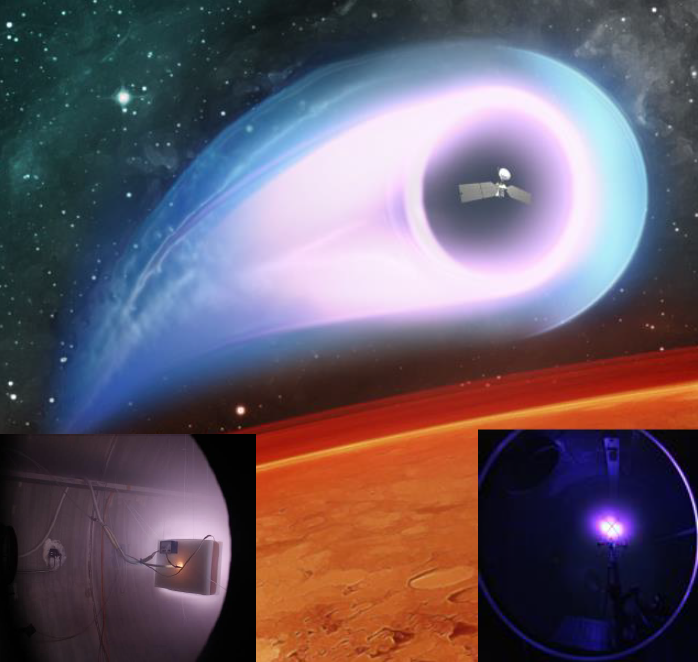David Kirtley
MSNW, LLC
Phase I Overview
It is clear from past mission studies that a manned Mars mission, as well as deep space planetary orbiters will require aerobraking and aerocapture which use aerodynamic drag forces to slow the spacecraft. Aerocapture would enable long term studies of the outer planets and their moons that would not be possible with existing braking technologies. While utilizing planetary atmospheres to slow down and capture spacecraft would dramatically reduce the cost, launch mass, and travel time, current technologies require significant additional spacecraft mass and risk, as the spacecraft must descend deep into a planetary atmosphere that is not well characterized in order to produce significant drag on a relatively small, fixed dimension aeroshell or temperature and structurally sensitive inflatable ballute.
The Magnetoshell deploys a simple dipole magnetic field containing a magnetized plasma. It is interaction of the atmosphere with this magnetized plasma that supplies a significant impediment to atmospheric flow past the spacecraft, and thereby producing the desired drag for braking. Frictional heating would no longer be of concern as the energy dissipation required to slow the spacecraft would be deposited into the plasma ions helping to maintain the Magnetoshell plasma while at the same time shielding the spacecraft itself from frictional heating. With the aeroshell now being composed of massless magnetic field, the transverse scale of the magnetic barrier can be as large as 100 meters while requiring no more than a gram of plasma. With the ability to rapidly and precisely modify the drag in varying atmospheric conditions, much larger forces can now be achieved at low risk, enabling very aggressive aerocapture maneuvers. By providing power in a pulsed manner, the thermal and power processing requirements can be kept modest and with conventional technologies.
In Phase I a full system was designed for Neptune and Mars missions. This analysis showed that a 200 kg, 2 m magnet could generate a 9 m radius Magnetoshell for Neptune aerocapture with a 21 km/s injection at a peak force of 150 N entirely removing the need for a TPS. At Mars, a 2.5 m magnet could generate a 21 meter radius Magnetoshell, providing aerocapture for a 60 metric ton payload removing the dedicated aerocapture TPS and saving $2 B for DRA 5.0. A transient analytic model was developed evolving the radial plasma parameters for a variety of plasma, neutral, and magnetic parameters. Finally, a stationary 1.6 meter argon Magnetoshell was fully demonstrated and a 1000:1 increase in aerodynamic drag was found. This experimental program definitively demonstrated a subscale Magnetoshell by eliminating electromagnetic interference, utilizing a dielectric torsional thrust stand, and placing all key electrical components under vacuum in the plasma environment. In addition, by decrease the dynamic pressure requirements while simultaneously shielding the spacecraft, heating during an Aerocapture maneuver could be reduced by 10,000X. In the proposed Phase II, the complete mission benefits of the Magnetoshell system will be proven. During this Phase II detailed mission studies will investigate the 3D orbital entry and capture mechanics while investigating the thermal, structural, electrical, and magnetic requirements of a Magnetoshell system. These studies will determine the risk, cost, and overall benefits of a full scale Magnetoshell aerocapture system for a range of science and manned missions to the inner and outer solar system. A hypersonic plasma-neutral interaction validation study will prove the fundamental particle and plasma effects at 10 to 15 km/s velocities and relevant densities. And finally, a detailed Aerocapture orbital gravity model, based on the satellite tour design program (STOUR) will be developed to model in 3D, the full dynamics of an interplanetary, 60 meter Aerocapture system.
































